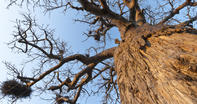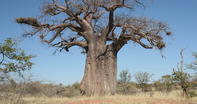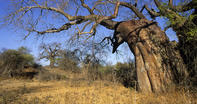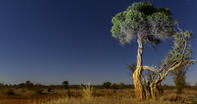The Tree Spotting Trend
Tree spotting is definitely a thing and there are several guide books to prove it.

And, unlike birds or animals, trees stay put so you’ll always know where to find them. While the Kruger National Park is awash with many different tree species, here is a quick intro to two of the park’s most iconic specimens.
The Famous Upside-Down Tree

The iconic baobab tree (Adansonia digitata) is found throughout the Lowveld, starting around the Tropic of Capricorn and moving northwards. It is an amazing and unmistakable botanical life form, growing up to 30 metres tall with an expansive circumference of 10 metres or more.
The species was first described by Adanson, a French botanist, who studied them on the Cape Verde islands. While we only have one species of baobab in Africa (digitata), there are actually eight species of Adansonia – six of which are found in Madagascar and one in Australia. Baobabs begin life as a curious, smooth-barked sprout with a bulbous bottom and narrow neck.
As they grow, they store considerable amounts of water in their trunks, which causes the trees to swell and buckle as they mature. The bark also develops many knots and ripples, and reminds me of an elephant’s rough hide.
Many of the older baobabs eventually develop a hollow centre, which are often large enough to offer animals and even humans a shady refuge on a hot day. There’s even one tree in Limpopo Province that functioned as a novelty saloon in the gold mining days.
Great Size, Great Age

Their great size suggests great age, but there is some disagreement about how slow a baobab grows. Most people assert that they grow slowly and can reach an age of several thousand years. Others dispute this and claim that they are much younger than they look. However, unlike most trees, baobabs do not form annual growth rings, so botanists will just have to keep a close watch.
Baobabs are deciduous trees, which lose all their leaves in winter. This reveals a mass of angular branches that reach out to the sky in an arthritic embrace. The distinctive shape of these denuded branches has given the baobab one of its nicknames: the upside-down tree, so called because it looks like the tree has been flipped on its head, with the roots sticking up into the sky.
Cream of Tartar
Just about every part of the baobab can be utilised by humans. The leaves can be boiled and eaten. The pollen of the flowers can be made into a kind of glue. The wood can be used to make rope or paper. Medical unguents and remedies can be concocted. Even the seeds can be sucked for flavour or ground into a palatable coffee (apparently).
The fruit pod also contains tartaric acid, which can be collected and made into a yoghurty, sherbet-like dessert. This is the source of the Afrikaans name for the tree: kremetart, which I foolishly thought meant ‘Cream tart’ but actually translates as ‘cream of tartar’. In other parts of the world, the baobab is also known as the Monkey-bread tree and the Sour-gourd tree.
Tree of Reconciliation

The Shepherd’s Tree (Boscia albitrunca) is a relatively common evergreen species that is found throughout the Kruger National Park region. It gets its name because it is a favourite resting place for local folk who are tending their herds. Their choice is a good one as the tree has thin leaves, which offer shade while still letting the breeze blow through.
The components of the Shepherd’s tree also have several medicinal properties. Apart from its practical uses, the tree has considerable social significance. It is renowned as a tree of reconciliation. So, when there’s a problem in the village, people take a branch from the Shepherd’s Tree and place it in the middle of the meeting to help them find a resolution to the conflict.
By David Fleminger South Africa has a plethora of iconic, indigenous trees that add to the beauty of South African biodiversity. SouthAfrica.co.za delivers fac...
South Africa has a plethora of iconic, indigenous trees that add to the beauty of South African biodiversity. SouthAfrica.co.za delivers fac...